Digital Posters
Functional Connectivity Applications
ISMRM & SMRT Annual Meeting • 15-20 May 2021

| Concurrent 3 | 17:00 - 18:00 |
3145.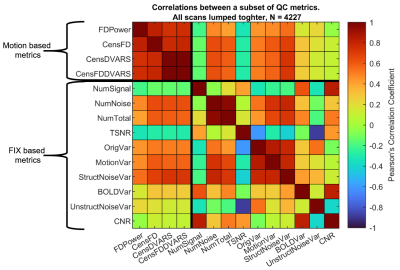 |
A quality-control database for the resting-state young-adult human connectome project
Daniele Mascali1,2, Antonio Maria Chiarelli1, Richard Geoffrey Wise1, and Federico Giove2
1Institute for Advanced Biomedical Technologies, Department of Neuroscience, Imaging and Clinical Sciences, "G. D'Annunzio University" of Chieti-Pescara, Chieti, Italy, 2Centro Fermi - Museo storico della fisica e Centro studi e ricerche Enrico Fermi, Rome, Italy
The human connectome project collected resting-state data from over 1000 healthy young-adult subjects. Looking beyond its original purpose, this database represents a valuable resource for benchmarking denoising pipelines. Unfortunately, quality control data for selecting scans with opposite noise characteristics, such as scans with extremely low or high head motion, are not publicly available. Here, we explored the entire resting-state human connectome project to provide researchers with a database of quality control metrics. Using the database, we constructed two instances of samples with suitable features for benchmarking purposes.
|
|||
3146.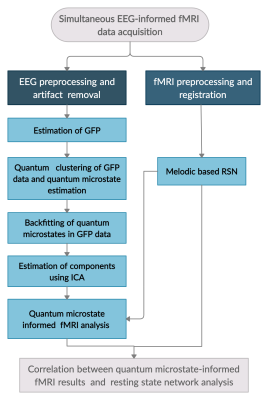 |
EEG Quantum Microstates correlate with resting state fMRI networks
Sneha Vaishali Senthil1, Vijayakumar Chinnadurai1, Ardaman Kaur1, Pawan Kumar1, Prabhjot Kaur1, and Maria D Souza1
1NMR Division, Institute for Nuclear Medicine and Allied Sciences, Delhi, India
Association between slowly varying rs-fMRI networks and rapidly varying topographical EEG microstates is yet to be explored. We propose a novel quantum microstate-based clustering approach to assess quasi-stable patterns in resting state-EEG signals and analyze their association with rs-fMRI networks (RSNs). Clustering results were estimated by constructing a scale-space probability function from dynamic EEG potentials and the eigenstates in Hilbert space was assessed. These quantum-EEG microstate informed RSNs exhibited correlation with frontoparietal, posterior DMN, executive, visual and sensori-motor networks. The sub-second coherent neural activation within global large-scale functional brain networks may help investigate different mental health states.
|
|||
3147.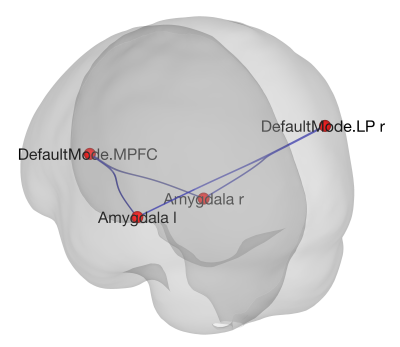 |
The effects of one rTMS session on the left DLPFC on episodic future thinking: preliminary results.
Peter Van Schuerbeek1, Linde De Wandel2, Sam Bonduelle3, Djamila Bennabi4, and Chris Baeken3
1Radiology, UZ Brussel (VUB), Brussels, Belgium, 2Head and Skin, UGent, Ghent, Belgium, 3Psychiatry, UZ Brussel (VUB), Brussels, Belgium, 4Laboratoire de Neurosciences Intégratives et Cliniques, Université de Bourgogne Franche-Comté, Bourgogne, France Episodic future thinking (EFT) is the ability to imagine events to occur in one’s personal future. In this study, we studied the interaction of one rTMS session on the left DLPFC with EFT on the connectivity between areas from the DMN, the hippocampus and the amygdalae. All participants performed an EFT task before and 1 hour after a real or sham rTMS session during a fMRI scan. Our preliminary results showed interesting changes in the connectivity between the MPFC and right LP with both amygdalae. However, more data is needed to strengthen these results. |
|||
3148. |
Tracing effects of breath-training on healthy brains using RS-fMRI
hacer dasgin1, naciye vardar yagli2, melda saglam2, and kader karli oguz3
1National Magnetic Resonance Research Center (UMRAM), Bilkent University, Ankara, Turkey, 2The Faculty of Physical Therapy and Rehabilitation, Hacettepe University, Ankara, Turkey, 3Faculty of Medicine, Department of Radiology, Hacettepe University, Ankara, Turkey
The present study was conducted to investigate the effects of Inspiratory Muscle Training (IMT) on brain activity in healthy people using resting state functional magnetic resonance imaging (RS-fMRI). Participants were assigned into a training group (n=14), which consisted of 2 subgroups, namely sham group (n=7) and treatment group (n=7) and their native a baseline (n=14) group. Apart from global correlations, brain intrinsic networks differences between groups and subgroups were also examined. Compared to the baseline and sham there was a decrease in global BOLD signal changes and more localized clusters of activation in the treatment group.
|
|||
3149. |
Functional connectivity markers of cross-modal inhibition: Effects of auditory and visual stimulation on homo- and hetero-modal brain networks
Anissa L. Ramadhani1,2, Ali-Reza Mohammadi-Nejad1,2,3, Katrin Krumbholz2,4, and Dorothee Auer1,2,3
1Radiological Sciences, DCN, School of Medicine, University of Nottingham, Nottingham, United Kingdom, 2SPMIC, School of Medicine, University of Nottingham, Nottingham, United Kingdom, 3National Institute for Health Research (NIHR), Nottingham BRC, Queens Medical Ctr, Nottingham, United Kingdom, 4Hearing Sciences, DCN, School of Medicine, University of Nottingham, Nottingham, United Kingdom
Functional magnetic resonance imaging (fMRI) studies have suggested that neural variability and connectivity (temporal coherence) are generally reduced during active versus passive (or resting) brain states. In this study, we investigate if this reduction in brain coherence is a supra-modal or modality-specific effect. For that, we compared BOLD signal during rest and whilst performing a continuous auditory or visual task. Our results suggest that task-induced reduction in brain coherence occurs only in default-mode and hetero-modal brain regions.
|
|||
3150.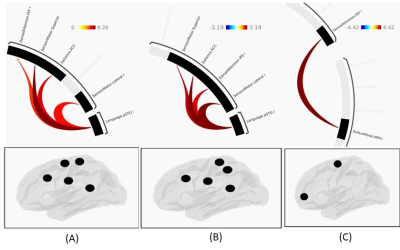 |
Characteristics of frequency specificity associated with memory cognition.
Himanshu Singh1, S Senthil Kumaran1, A Ankeeta1, and Shefali Chaudhary1
1Department of NMR, All India Institute of Medical Sciences, New Delhi, India
Spoken word and its underlying semantic cognition has a complex interaction and is an unexplored domain. We designed a 1-back auditory working memory task to understand the semantic context, where individual’s frequency characteristics are quantified through audiometric tests. Task connectome analysis is parametrically modulated with frequency parameters to highlight the effect of frequency specificity, to distinguish the characteristics of auditory cognition from perception to cognition aspect. The semantic cognition is associated to frequency specific nature of stimuli.
|
|||
3151.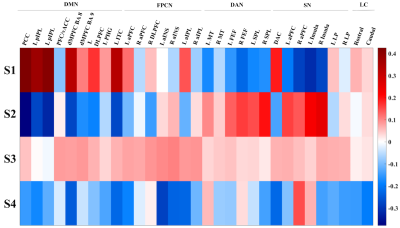 |
Locus coeruleus is associated with brain state switching
Sana Hussain1, Isaac Menchaca1, Mahsa Alizadeh Shalchy2, Kimia C. Yaghoubi2, Jason Langley3, Aaron R. Seitz2, Megan A.K. Peters4, and Xiaoping P. Hu1,3
1Department of Bioengineering, University of California, Riverside, Riverside, CA, United States, 2Department of Psychology, University of California, Riverside, Riverside, CA, United States, 3Center for Advanced Neuroimaging, University of California, Riverside, Riverside, CA, United States, 4Department of Cognitive Sciences, University of California, Irvine, Irvine, CA, United States
Locus coeruleus (LC) is involved in attention and other brain functions. We ascertained how LC activity up-regulation affects brain states derived from a hidden Markov model. Upon up-regulating LC activity, we found increased pupil size during state switching. This may indicate an increase in LC activation during the state switching process. Specifically, significant interactions between state and condition were observed when transitioning into the default mode network, but not into attention networks. The lack of interaction may be due to LC already being active during transitions into the attention network.
|
|||
3152.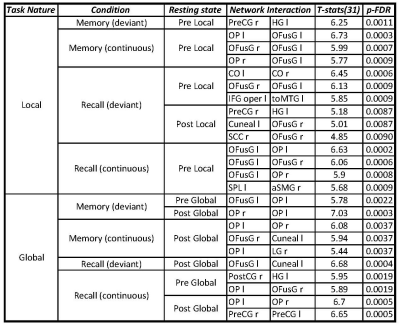 |
Dynamic nature of resting networks across different brain states in auditory attentional framework.
Himanshu Singh1, S Senthil Kumaran1, and A Ankeeta1
1Department of NMR, All India Institute of Medical Sciences, New Delhi, India
Understanding the hemodynamic signature of experience elucidating cognition is an important feature of dynamic functional connectivity. Quantification of such dynamic microstate may play a role across neuro disorders. We employed a rest-task-rest design of Navon paradigm with auditory load to highlight the feature of dynamic networks specific to task. Quantifying perception stage of stimuli reveal dynamic interaction limited to task specific attention and information processing networks (even across resting phase) and predict dynamic nature across brain states.
|
|||
3153.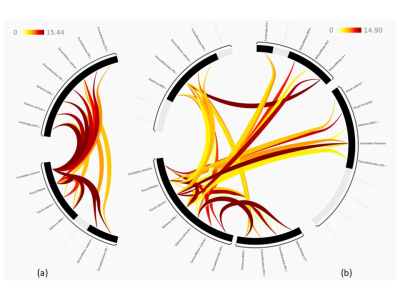 |
Frequency heterogeneity of semantic language perception in auditory cognition.
S Senthil Kumaran1, Himanshu Singh1, A Ankeeta1, and Shefali Chaudhary1
1Department of NMR, All India Institute of Medical Sciences, New Delhi, India
Specificity of semantic cognition to characteristics of audio information is a complex interaction of executive and sensory networks. A 2-back auditory working memory task and audiometric assessments were analysed to study the information processing of semantic cognition. A gPPI analysis with frequency modulation were computed for connectome analysis. Interaction of network with respect to the frequency exhibited significant correlation for modulated frequency domain and no interaction for characteristic frequency domain, which suggest frequency heterogeneity during semantic language processing.
|
|||
3154.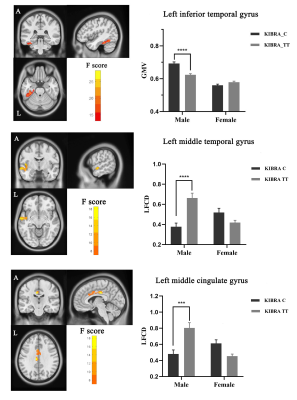 |
KIBRA rs17070145 interacts with gender on brain gray matter volume and functional connectivity density in healthy young adults
Junxia Wang1, Sichu Wu2, Jiaming Lu1, Jilei Zhang3, Zhao Qing1,4, and Bing Zhang1
1Department of Radiology, Nanjing Drum Tower Hospital, The Affiliated Hospital of Nanjing University, Nanjing, China, 2The Affiliated Brain Hospital of Nanjing Medical University, Nanjing, China, 3Philips Healthcare, Shanghai, China, 4Institute for Brain Sciences, Nanjing University, Nanjing, China
KIBRA rs17070145 and gender have been found to have associations with episodic memory. However, the underlying mechanisms and their combined effects on the brain gray matter volume (GMV) and functional connectivity density (FCD) remain unknown. This study found that KIBRA gene interacted with gender on the GMV and long-range FCD (lrFCD) using voxel-based morphometry (VBM) analysis. These findings underscored the importance of KIBRA and gender interactions as regards to brain structural and functional alterations, which is crucial for the neurobiological understanding of episodic memory.
|
|||
3155.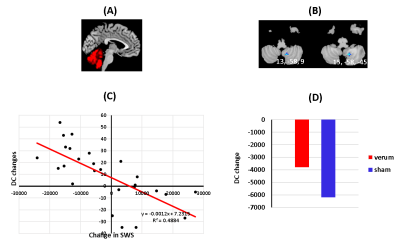 |
Global Connectivity of the Cerebellum Predicts Slow Wave Sleep Improvement: A Randomized Controlled Acupuncture Trial
Ran Pang1,2, Xi Wu3, Yuchen Chi4, Rommy Elyan5, Xianke Luo6, Zhigang Chen6, Qingxian Yang2, Karunanayaka Prasanna7, and Kuncheng Li8
1Department of Radiology, Dongfang Hospital, Beijing University of Chinese Medicine, Beijing, China, 2Department of Neurosurgery, Pennsylvania State University College of Medicine, Hershey, PA, United States, 3Department of Acupuncture, Dongfang Hospital, Beijing University of Chinese Medicine, Beijing, China, 4Department of Otolaryngology, Dongfang Hospital, Beijing University of Chinese Medicine, Beijing, China, 5Department of Radiology, Pennsylvania State University College of Medicine, PA, USA, Hershey, PA, United States, 6Department of Neurology, Dongfang Hospital, Beijing University of Chinese Medicine, Beijing, China, 7Department of Radiology, Pennsylvania State University College of Medicine, Hershey, PA, United States, 8Department of Radiology, Xuanwu Hospital, Capital Medical University, Beijing, China
The cerebellum is an important brain structure for sleep. We identified a global connectivity mechanism with which the cerebellum coordinates and controls sleep-related networks. Global connectivity of the cerebellum showed a highly selective relationship with individual differences in slow-wave sleep (SWS) improvements, after both verum and sham acupuncture treatments. Cerebellar connectivity with the thalamus differed significantly between treatment types. Highlighting its ability to distinguish amongst processes central to sham and verum treatments. Our findings suggest a particular architecture for the cerebellum: a flexible global hub with a brain-wide influence, supporting both circadian rhythms and sleep homeostasis.
|
|||
3156.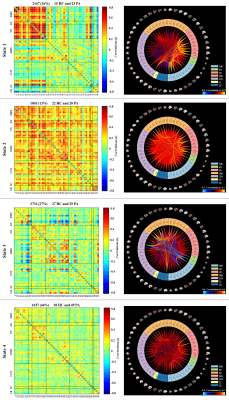 |
Dynamic functional network connectivity differences and its association with neurocognitive changes in cirrhotic patients
Jia Yan Shi1, Zhong Shuai Zhang2, and Hua Jun Chen1
1Department of Radiology, Fujian Medical University Union Hospital, Fuzhou, China, 2SIEMENS Healthcare, Shanghai, China
We aimed to explore dynamic functional network connectivity (dFNC) differences and to elucidate their association with neurocognitive changes in cirrhotic patients. Sliding window correlation approach was employed to calculate dFNC. FNC states were determined by k-means clustering method, and then state analysis was conducted. The patients showed decreased FNC in State 2 and state 3. The patients spent significantly longer time in State 4 that was with weakest FNC. We observed a significant correlation between Psychometric Hepatic Encephalopathy Score and fraction time/mean dwell time in State 4. Aberrant dFNC may be the underlying mechanism of neurocognitive impairments in cirrhosis.
|
|||
3157.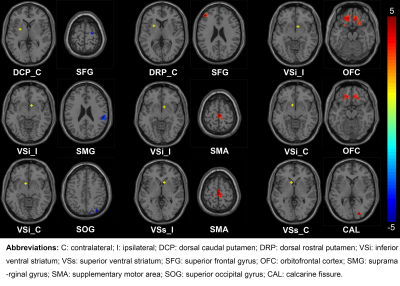 |
Altered cortical-striatal network in patients with hemifacial spasm
Wenwen Gao1, Lei Du1, Bing Liu1, Yue Chen1, Yige Wang1, Xiuxiu Liu1, Lizhi Xie 2, and Guolin Ma1
1China-Japan Friendship Hospital, Beijing, China, 2GE healthcare, China, Beijing, China
Hemifacial spasm (HFS) is a motor disorder. The purpose of this study was to explore the alterations of the cortical-striatal network in HFS using resting-state fMRI. We found that the functional connectivity (FC) between the putamen and ventral striatum and both motor and emotion-related cortex was increased in patients with HFS compared to the healthy controls. The FC between the ventral striatum and the motor cortex was positively correlated with the spasm intensity. To sum up, HFS may lead to altered neural activity in the cortical-striatal loop.
|
|||
3158.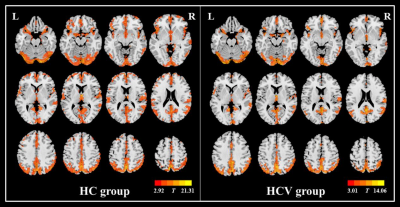 |
Alterations in regional and network-level neural function in patients with HCV infection and its association with cognitive dysfunction
Jia Yan Shi1, Zhong Shuai Zhang2, and Hua Jun Chen1
1Department of Radiology, Fujian Medical University Union Hospital, Fuzhou, China, 2SIEMENS Healthcare, Shanghai, China
We aimed to investigate alterations in regional and network-level neural function in patients with hepatitis C virus (HCV) infection and examine the association between these alterations and patients’ cognition dysfunction. HCV-infected patients performed significantly worse in the cognitive tests. In the HCV group, amplitude of low-frequency fluctuation (ALFF) decreased in two prefrontal regions (Region-1and Region-2). The HCV group showed lower FC between the Region-1 and right middle frontal gyrus; whereas they presented an increase in FC between Region-2 and bilateral parietal-temporal cortex. HCV infection affects brain function, including local intrinsic neural activity and global functional integration.
|
|||
3159.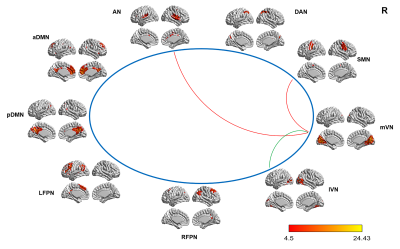 |
Brain structural and functional reorganization in tinnitus patients without hearing loss after sound therapy: a preliminary longitudinal study
Qian Chen1, Han Lv1, Zhaodi Wang2, and Zhenchang Wang1
1Department of Radiology, Beijing Friendship Hospital, Capital Medical University, Beijing, China, 2Department of Otolaryngology Head and Neck Surgery, Beijing Friendship Hospital, Capital Medical University, Beijing, China
Idiopathic tinnitus patients experienced significant differences in auditory-related and nonauditory-related brain reorganization before and after sound therapy (narrow band noise), that is, sound therapy may have a significant effect on brain reorganization in patients with idiopathic tinnitus.
|
|||
3160.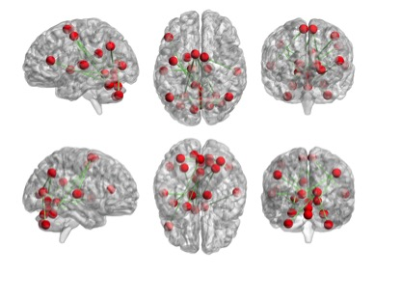 |
Altered small-world, functional brain networks in patients with postherpetic neuralgia
jian jiang1 and yanwei miao1
1The first affiliated hospital of Dalian medical university, Dalian, China
This study investigated the link between PHN and the small-world properties of functional networks within the brain.
|
|||
3161.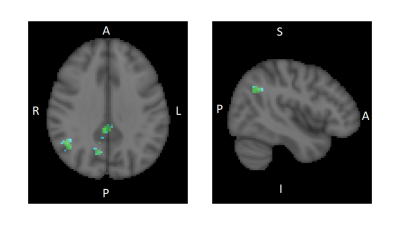 |
Clavulanic Acid Alters Functional Connectivity of the Anterior Cingulate Cortex in Subjects with Cocaine Use Disorder: A Pilot fMRI Study
Helene L Philogene-Khalid1,2, Eric M Cunningham1, Mary F Morrison1,2, and Nicolas R Bolo3,4
1Psychiatry, Lewis Katz School of Medicine at Temple University, Philadelphia, PA, United States, 2Center for Substance Abuse Research, Lewis Katz School of Medicine at Temple University, Philadelphia, PA, United States, 3Psychiatry, Beth Israel Deaconess Medical Center, Boston, MA, United States, 4Psychiatry, Harvard Medical School, Boston, MA, United States
Unlike alcohol and nicotine, there is no FDA-approved pharmacological treatment for cocaine use disorder (CoCUD). The purpose of this study was to investigate clavulanic acid (CLAV), a GLT-1 activator, for its potential to treat CoCUD. Resting state fMRI was used to assess changes in the anterior cingulate cortex (ACC) functional connectivity with repeated CLAV for 10 days. CLAV altered the connectivity of ACC with default mode network, motor control, and addiction cue reactivity related regions. This pilot study supports the development of CLAV for CoCUD treatment.
|
|||
 |
3162.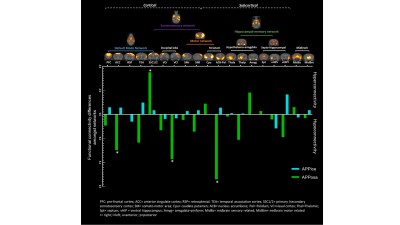 |
Can familial Alzheimer variability affect brain networks? Exploration through Osaka Ab variant inoculation in mice.
Marina Celestine1, Jean-Baptiste Pérot1, Muriel Jacquier-sarlin2, Karine Cambon1, Julien Flament1, Alain Buisson2, Anne-Sophie Hérard1, and Marc Dhenain1
1Université Paris-Saclay, Commissariat à l’Energie Atomique et aux Energies Alternatives (CEA), Centre National de la Recherche Scientifique (CNRS), Molecular Imaging Research Center (MIRCen), Laboratoire des Maladies Neurodégénératives, Fontenay-aux-roses, France, 2University Grenoble Alpes, Inserm, U1216, Grenoble Institut Neurosciences (GIN), Grenoble, France
Early brain dysfunctions found in Alzheimer's disease are due to soluble pathological forms of b-amyloid peptide (Aβ). Among the familial Aβ mutations, the Osaka-Aβ variant is characterized by the intraneuronal accumulation of toxic Aβ without forming extracellular Aβ deposition. It affects synaptic function by modulating excitatory pathways leading to memory defects. Here, we performed a multimodal study to unveil brain network signatures of the pathology. Combining resting-state fMRI, gluCEST and diffusion analysis, we revealed that exposition to Osaka-Aβ leads to abnormal brain connectivity through impairment of the default mode and the hippocampal-memory networks.
|
||
3163.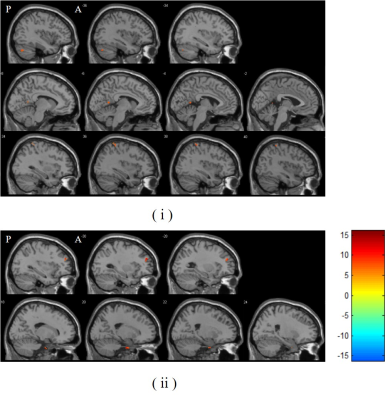 |
Changes in Gray Matter Volume and Functional Connectivity of Obese Females with Acupuncture and Diet Control Therapy: Placebo Effect or Not?
Jiawei Han1, Hui Zhang2, Junqi Xu2, Fanwen Wang2, Jian Gao3,4, Weibo Chen5, Hongmei Yan6, and He Wang1,2
1Human Phenome Institute, Fudan University, Shanghai, China, 2Institute of Science and Technology for Brain-Inspired Intelligence, Fudan University, Shanghai, China, 3Department of Nutrition, Zhongshan Hospital, Fudan University, Shanghai, China, 4Center of Clinical Epidemiology and Evidence-based Medicine, Fudan University, Shanghai, China, 5Philips Healthcare, Shanghai, China, 6Department of Endocrinology, Zhongshan Hospital, Fudan University, Shanghai, China
Weight loss is a stressful process for obese women, and effects on their physiology and psychology vary from different methods to lose weight. Acupuncture is a relatively easy and effective way, but its mechanism is still unclear. To investigate these phenomena, 16 obese females were recruited to participate in this MRI study. Our results show that the weight loss methods of acupuncture and diet control increase gray matter volume in different regions, and the influence of acupuncture for functional connectivity might be lighter, which is likely to reveal the acupuncture principles and the psychological impact on patients.
|
|||
3164.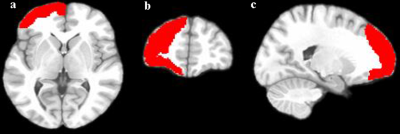 |
The Changes in Longitudinal ALFF and ReHo Values of Methamphetamine Abstinence Subjects Based on Harvard-Oxford Atlas
Yanyao Du1, Ru Yang1, Wenhan Yang1, Huiting Zhang2, and Jun Liu1
1Department of Radiology, the Second Xiangya Hospital of Central South University, Changsha, China, 2MR Scientific Marking, Siemens Healthcare Ltd., Wuhan, China This study aimed to explore the changes of amplitude low-frequency fluctuation (ALFF) values nearly one-year before and after abstinence in patients with Methamphetamine Abstinence (MA), and to investigate potential imaging markers related to withdrawal based on Harvard-Oxford Atlas. Compared with short-term abstinence group, right middle frontal gyrus (8) and right inferior frontal gyrus, pars triangularis (10) had significantly higher ALFF value at long-term abstinence group. The ALFF value of the two regions may be a new biomarker which can reflect the impact of withdrawal on brain function. |
The International Society for Magnetic Resonance in Medicine is accredited by the Accreditation Council for Continuing Medical Education to provide continuing medical education for physicians.